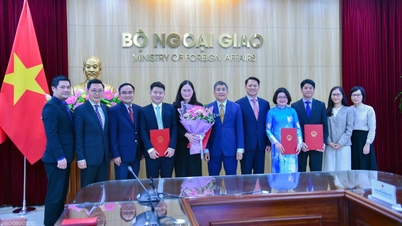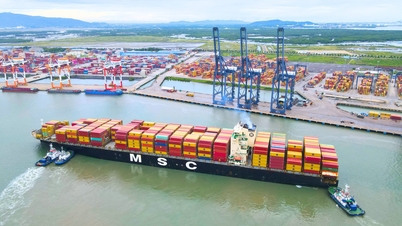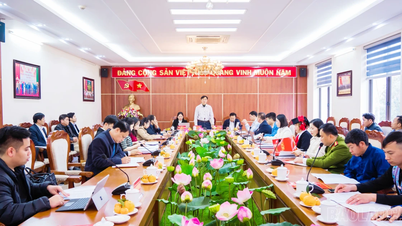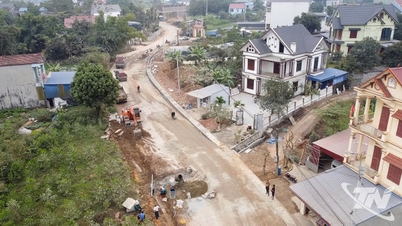At the thematic seminar "Important Information for Real Estate Investors" held on June 7th, organized by SB LAW Law Firm in collaboration with Gofland Club, experts discussed solutions and proposed strategic approaches for the real estate market.
The event not only provided updates but also served as an open forum, bringing together diverse voices from economic experts, policymakers, leading businesses, and leaders of exchanges directly involved in implementing real-world projects in the market.
 |
| Overview of the thematic seminar "Important Information for Real Estate Investors" on June 7th. (Photo: Hong Chuyen) |
Speaking at the seminar, Dr. Can Van Luc, Chief Economist of BIDV Bank, said that in recent times, the Vietnamese economy in general and the real estate market in particular have faced numerous difficulties and challenges due to the combined impact of domestic and international factors. Pressure from inflation, interest rates, tight credit flows, and global economic fluctuations have seriously affected the production and business capacity of many real estate enterprises.
Against this backdrop, the Party and State have clearly demonstrated special attention to the real estate sector through the continuous review, amendment, and supplementation of many important legal mechanisms and policies. Along with this, a comprehensive set of support solutions has been implemented, with numerous directives and instructions issued by the Government and ministries, aiming to gradually resolve obstacles, restore confidence, and move towards the goal of developing the real estate market in a safe, healthy, and sustainable manner.
Driving forces for the real estate market.
Dr. Can Van Luc predicts that the global economy will continue to experience weak growth of only about 2.8% in the 2025-2026 period (lower than 3.3% in 2024 and 3.5% in the 2011-2019 period). Global inflation will decrease slightly, trade will grow slowly, and interest rates will only cool down gradually. In addition, real estate businesses are currently facing obstacles such as input costs, logistics, and the requirements for digitalization and greening…
However, Mr. Luc believes that the economy is showing positive signs and growth drivers are recovering fairly evenly. Accordingly, domestic consumer demand is recovering, exports are increasing significantly but are slowing down; private investment is recovering, FDI is increasing significantly but may slow down; public investment is being boosted. Services (especially tourism, accommodation - food and beverage, logistics, finance - banking, etc.) are increasing significantly; the stock and real estate markets are gradually recovering…
Furthermore, the "Four Pillars" comprising: Resolution No. 57-NQ/TW of the Politburo on breakthroughs in the development of science, technology, innovation, and national digital transformation; Resolution No. 59-NQ/TW of the Politburo on international integration in the new situation; Resolution No. 66-NQ/TW of the Politburo on reforming the work of drafting and implementing laws to meet the requirements of national development in the new era; and Resolution No. 68-NQ/TW of the Politburo on the development of the private economy, have together created a unified whole in strategic thinking and action for national development.
 |
| Dr. Can Van Luc, Chief Economist of BIDV Bank, warned that although the real estate market has recovered, it still harbors the risk of a price bubble. (Photo: Hong Chuyen) |
In the real estate sector, three important laws – the Land Law, the Housing Law, and the Real Estate Business Law – have been passed and are in effect, providing significant support to the market in the current and future context. These are positive signals to promote efficient and sustainable market development. In addition, the market is also receiving substantial support from resolutions and decrees issued by the Politburo, the National Assembly, and the Government, such as: Resolution 170/2024/QH15 and Decree 76/2025/ND-CP on removing legal obstacles for projects and land in inspection conclusions and judgments in Ho Chi Minh City, Da Nang, and Khanh Hoa; Resolution 171/2024/QH15 and Decree 75/2025/ND-CP on piloting the implementation of commercial housing projects through agreements on land use rights or existing land use rights (“residential land and other land”); Resolution 201/2025/QH15 dated May 29, 2025, on piloting a number of specific mechanisms and policies for the development of social housing…
"New impetus from policies and laws, along with increased infrastructure investment, is opening up new expectations for the real estate market," Mr. Luc affirmed.
Implement the strategic solutions group.
Expert Can Van Luc also pointed out the risks and challenges of the real estate market: trade and technology conflicts impacting logistics real estate, industrial parks, housing demand, tourism, and consumption; slow and uneven disbursement of public investment; certain difficulties in merging provinces and cities; private investment is projected to increase significantly in the coming period; administrative procedure reform requires time for resolution and implementation; the real estate market recovery lacks sustainability, and prices remain high...
Facing the challenges and opportunities for development in the new context, Dr. Can Van Luc believes that real estate businesses need to implement a group of strategic solutions such as: Continuing to restructure operations; paying attention to controlling cash flow risks and handling maturing debt (approximately 93,500 billion VND of corporate bonds will mature in 2025); proactively researching and accessing support policies, especially social housing support packages, infrastructure investment, and new resolutions and decrees…
In addition, Dr. Can Van Luc also warned that although the real estate market has recovered, it still harbors the risk of a price bubble, requiring businesses to be cautious and policies to be transparent. In particular, the stock market increased by 5.2% in the first five months of 2025, nearly double the same period last year, but still lacks stability. Therefore, improving corporate governance capacity, managing exchange rate and interest rate risks, and complying with financial regulations are key factors for sustainable development.
Merging provinces will create strong growth centers.
Mr. Nguyen Quoc Anh, Deputy General Director of Batdongsan.com.vn, said that in recent times, the merger of administrative units has attracted great attention from real estate investors. The merger of provinces and cities is considered one of the resources to promote economic development. For a locality to develop sustainably, it is essential to ensure sufficient population size, resources, and infrastructure.
According to Mr. Quoc Anh, after conducting a survey, Batdongsan.com.vn found that Vietnam currently has 64 provinces/cities, with an average population of over 1 million people per province. Compared to other countries, the difference is significant. China has only over 30 provincial-level administrative units, but each province has an average population of approximately 30-40 million people. Even the US and many other countries have a centralized administrative structure, with a much larger population size per unit.
 |
| Mr. Nguyen Quoc Anh, Deputy General Director of Batdongsan.com.vn, shared his insights at the seminar. (Photo: Hong Chuyen) |
“This shows that Vietnam’s administrative structure is currently too fragmented, making governance difficult and leading to a dispersion of resources. When provinces are merged, resources will be more concentrated, creating favorable conditions for development. Although post-merger development cannot be uniform across all regions, concentration will create strong growth centers,” Mr. Quoc Anh said.
A prime example is the case of Da Nang and Quang Nam. Da Nang has strong development potential but is limited in terms of seaports and industrial land. Meanwhile, Quang Nam has advantages in resources and land area. Merging them would create a unified entity with clearer development potential.
In the long term, if tax and investment policies remain stable over the next 10 years, the growth rate will be very rapid. Therefore, in Batdongsan.com.vn's view, investors should not only look at short-term factors.
In the short term, investment trends often resemble an initial wave; upon hearing news of a merger, people rush to buy land with the expectation that "prices will definitely rise." However, reality shows that in many cases, after purchasing, land prices remain unchanged, infrastructure and planning remain the same, with no breakthroughs.
Therefore, a more long-term and thorough perspective is needed. After the merger, it is crucial to consider how resources will be allocated, whether infrastructure will be properly invested in, and whether the overall plan will help boost the province's economic development.
If a locality develops, residents earn better incomes, attracting labor and increasing the population, it will certainly lead to increased demand for investment, especially in real estate around where they live. From there, land prices can rise sustainably.
Source: https://baoquocte.vn/tan-dung-co-hoi-hoa-gia-i-thach-thuc-cho-thi-truo-ng-bat-dong-sa-n-trong-boi-ca-nh-moi-317148.html





























![[Photo] Prime Minister Pham Minh Chinh holds a phone call with the CEO of Russia's Rosatom Corporation.](/_next/image?url=https%3A%2F%2Fvphoto.vietnam.vn%2Fthumb%2F1200x675%2Fvietnam%2Fresource%2FIMAGE%2F2025%2F12%2F11%2F1765464552365_dsc-5295-jpg.webp&w=3840&q=75)










































































Comment (0)